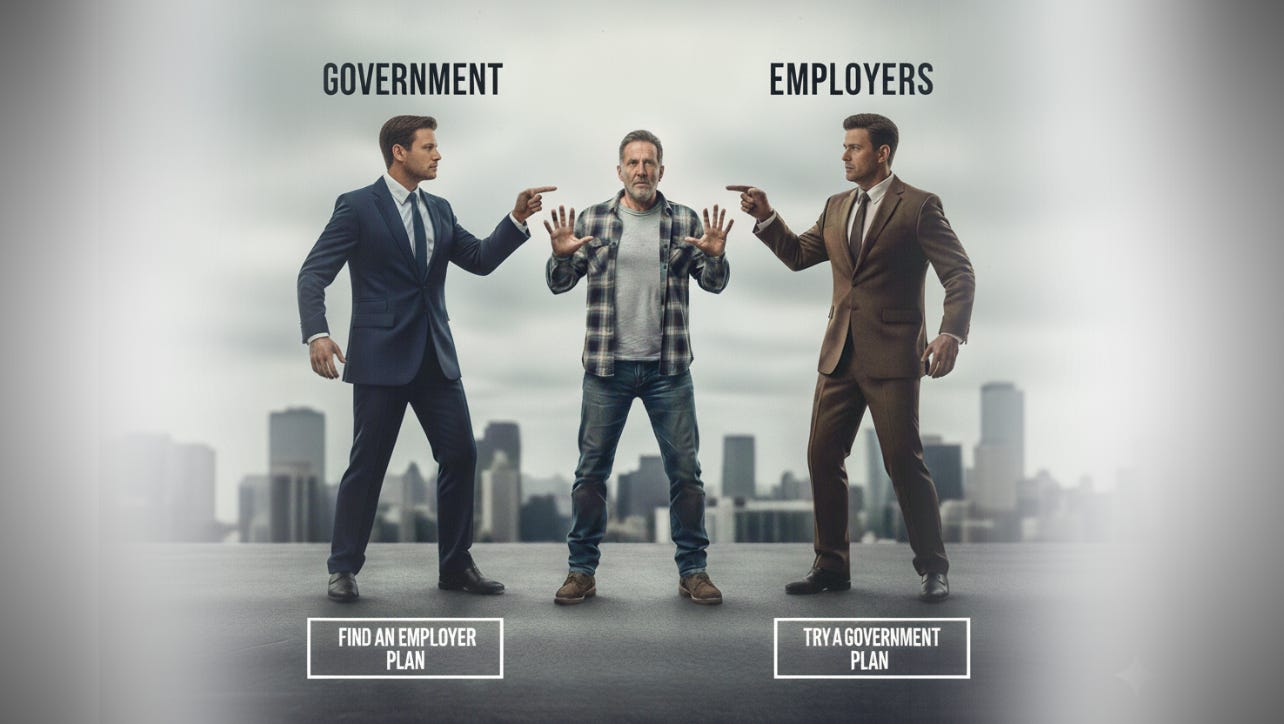The Great Healthcare Hand-Off
It’s hard to know which way middle-class Americans should turn when both the government and the private sector are pointing at each other, and pushing hard.
If you’re waiting for someone to take responsibility for America’s healthcare system, don’t hold your breath. Everyone’s running for the exits.
Just last week, Colorado’s Insurance Commissioner advised residents to seek coverage through their employers because marketplace plans have simply become too expensive. The message was clear: your boss is now your best hope for affordable care.
Nobody wants to own the problem
For the last decade, under the Affordable Care Act, American healthcare operated on the premise that if you had a job, your employer covered you. If you didn’t, government programs or the individual marketplace stepped in. The system was expensive and complicated, but at least it worked, sort of.
Not anymore.
Just a few months ago, Congress was exploring ways to expand the use of Individual Coverage Health Reimbursement Arrangements (ICHRAs), which allow employers to give workers money to buy their own insurance on the exchanges instead of providing coverage directly. It’s billed as a model that promotes choice and flexibility, but what it really signals is a retreat from traditional employer-sponsored coverage.
So, now we have a paradox: government officials are telling people to get employer coverage. Employers are trying to push people onto government exchanges. The two primary ways Americans obtain healthcare are telling them to look elsewhere, at the same time.
There’s nowhere to go
Let’s start with middle-class families that have decent jobs. Right now, most of these families have employer coverage. But if their employers adopt ICHRAs and send them to the marketplace, they’re in trouble. They likely earn too much to qualify for subsidies (and subsidies are a big part of what the current government shutdown fight is about) that would make coverage affordable. Instead, they’d be paying full price for plans that cost more and deliver less than what they have now.
Families who do qualify for subsidies face a different problem. The premium help gets them in the door, but these plans come with very high deductibles and out-of-pocket costs they can’t afford. They have coverage they can’t actually use. As costs spiral upward, the marketplace gets more unstable each year. Plans change. Networks shrink. And premiums keep climbing even with government help. And costs are going to keep climbing as more people drop out of the health insurance market, regardless of who’s paying for it, because they can’t afford their own share either way.
Workers between jobs, self-employed, or part-time get hit hardest. They have no employer coverage to fall back on. No defined contribution to help. They don’t qualify for subsidies. They’re shouldering the entire burden—full premiums, full deductibles, full out-of-pocket costs on a system that was never built to serve them directly.
If you’re managing a self-funded plan, you’re watching all of this while trapped yourself. Your costs are climbing past sustainable levels. The government says employer coverage is the answer, which means you’re supposed to be the answer. But your employees can’t afford the marketplace if you send them there. And you can’t absorb these increases much longer either. You’re being told to solve a problem that has no solution at these prices.
This is an affordability crisis hitting everyone at once. Nobody has a way out.
When both sides let go at once
Employer coverage has been eroding for years. Government programs have always had gaps. But we’ve never watched both major coverage sources try to redirect people elsewhere at the same time.
When your state’s insurance commissioner says to get employer coverage while employers explore ICHRAs to send workers to the marketplace, it isn’t a policy disagreement. This is a system out of options. Neither the government nor the private sector wants to own the problem. Both are looking for ways to offload responsibility. Both are failing to create a sustainable path forward.
The hand-off only works if someone is willing to catch the ball. What we’re watching now is both sides dropping the same pass.
This can’t end well.
We can keep treating coverage as a game of hot potato, or we can confront the structural contradictions that got us here. Until we do, costs will keep rising, access will keep declining, and frustration will keep growing. The solution isn’t pushing people back and forth between two broken options. We need to build a system that works no matter which direction you’re coming from.



